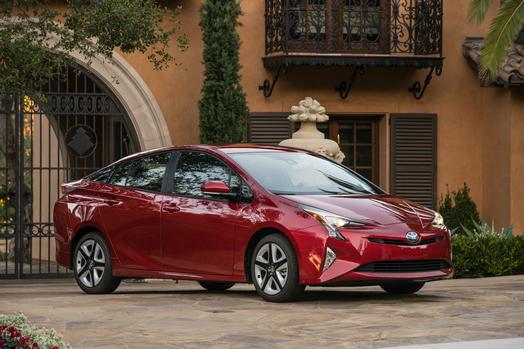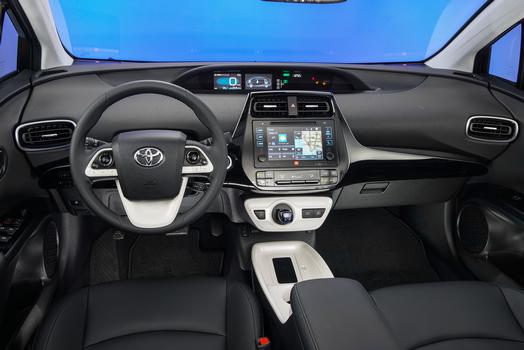The fourth-generation Toyota Prius enters its second year (and celebrates the 20th anniversary of its debut in Japan) as other carmakers are introducing their first hybrids. Meanwhile, the Prius liftback is one of eight Toyota hybrid models offered for 2017, and Toyota also offers the world’s first production hydrogen fuel-cell car for public sale, the Mirai.

The Prius still sets the bar for hybrid fuel economy, and it’s a high bar, indeed. The 2017 Prius Eco model is anticipated to receive MPG estimates of 58 city / 53 highway / 56 combined MPG EPA-estimated fuel economy ratings. That would be better than any mass-produced passenger vehicle without a plug.
While the auto industry was still grappling with those numbers, Toyota went ahead and announced its commitment to make automatic emergency braking standard on most of its models by the end of 2017. That will put Toyota (and Lexus) four years ahead of the model-year 2022 industry target announced by the National Highway Traffic Safety Administration (NHTSA) and Insurance Institute for Highway Safety (IIHS).
The 2017 Prius helps fulfill that commitment by making Toyota Safety Sense P (TSS-P) driver assist technology standard on all model grades. (It had been an option on select grades for 2016.) Using millimeter-wave radar and a monocular camera sensor to help detect pedestrians, vehicles, and lane markers in the surrounding area, TSS-P is designed to identify obstacles and automatically apply braking if necessary to help avoid collisions. TSS-P includes the Pre-Collision System with Pedestrian Detection; Lane Departure Alert with Steering Assist; Full-Speed Dynamic Radar Cruise Control and Automatic High Beams.
The Toyota Prius delivers mid-size room in a compact package, with a design that, while bolder than before, conveys an identity that’s instantly recognizable the world over. Offered in six model grades, the Prius caters to a wide variety of tastes and needs. The premium interior is distinguished by a wrap-around dash design, form-hugging seats, easy-to-use controls and enhanced visibility. The Prius is also the most connected and entertaining, with three Entune™ Multi-media systems available.
Breakthrough Efficiency
As impressive as Prius fuel economy has always been, Toyota relentlessly pursues ever-higher efficiency goals with each new design generation. The latest version of its Hybrid Synergy Drive combines the output of a 1.8-liter 4-cylinder gasoline engine and two motor/generators through an electronically controlled planetary-type continuously variable transmission (CVT). Shift-by-wire technology, which uses electric signals to transmit shift operations, offers light, fingertip operation from the dash-mounted shifter.
The fourth-generation Prius uses smaller, lighter hybrid components than before, including a lithium-ion hybrid battery that replaces the nickel-metal hydride battery (excluding the Prius Two standard grade). The battery’s smaller size and lower profile allow it to be packaged under the rear seat, rather than beneath the luggage area, yielding more cargo space.
The Prius driver can choose between selectable Normal and Power driving modes. Normal balances both fuel economy and acceleration feel; Power prioritizes acceleration feel. Most 2017 Prius models are expected to receive estimated economy ratings of 54 MPG city / 50 MPG highway / 52 MPG combined – on regular-grade gasoline. The Prius Eco grade anticipates higher ratings thanks to lighter weight and further optimized aerodynamics.
The Prius conserves energy even when it’s slowing down. The regenerative brake system switches the motor into a generator to recover the wheels’ kinetic energy as electrical power, storing it in the hybrid battery.
The Engine That Could – And Does
The Prius’ internal combustion engine is a star player on the Hybrid Synergy Drive team. The 2ZR-FXE 1.8-liter 4-cylinder gasoline engine achieves groundbreaking 40+ percent thermal efficiency, thanks to reduced internal friction and improved combustion. It’s also quieter than the previous generation’s engine. Toyota found extra efficiency by cooling the Exhaust Gas Recirculation (EGR) system, and by using exhaust heat recirculation to quickly bring engine coolant up to optimal temperature.
Because the Prius, under certain circumstances, can operate in battery mode alone, it incorporates a Vehicle Proximity Notification System to help alert pedestrians and cyclists. A small in-vehicle speaker emits a low but noticeable warning tone when traveling below approximately 15 mph, and the sound changes with vehicle speed.
Against the Wind, and Winning
Whether you call the new-generation Prius design modern, dramatic or emotional, it sure is smart. The Triangle Silhouette that defined the second and third-generation Prius models brings a sense of familiarity, now blended with a sense of daring.
Remember when “longer, lower, wider” described gas-guzzling leviathans? For the newest-generation Prius, those adjectives instead define a spacious, comfortable vehicle that cheats the wind without cheating passengers out of room. The vehicle’s 0.24 coefficient of drag (Cd) is among the lowest of current production passenger cars.
That’s achieved not only with the overall vehicle shape, but also details such as an automatic grille shutter that reduces drag by closing when airflow to the radiator is not needed. Aero stabilizing fins on the underfloor covers, front quarter window garnish and tail lamps likewise keep air moving in a smooth pattern. Front spats and covers on either side of the fuel tank help prevent airflow agitation by the tires and suspension.
See and Be Seen
The newest Prius design, while sleeker than before, does not compromise driver visibility – and in fact optimizes that attribute. Standard Bi-LED headlamps dominate the striking front fascia, and the rear combination lamps echo the design theme. Automatic headlamp leveling keeps the beams focused on the road and helps prevent blinding drivers in oncoming vehicles.
The newest design gives a clearer view to the rear, thanks to larger rear door glass and larger fixed rear quarter windows. As on the previous model, a full-width glass panel beneath the rear spoiler aids rearward visibility. A backup camera comes standard on all grades.
Toyota’s New Global Architecture (TNGA)
Beneath the Prius’ dramatic bodylines is the solid foundation of Toyota’s New Global Architecture (TNGA). In this current-generation Prius, the platform introduced a new high-strength body structure, the model’s first double-wishbone style multi-link rear suspension and a lower center of gravity. All combine to yield a highly engaging driving experience while also providing a markedly smoother and quieter ride than the previous generation.
The newest-generation Prius is 2.4 inches longer, 0.6 inches wider and 0.8 inches lower than the previous generation. The gasoline engine, electric motor and seating positions were lowered to increase front and rear head room while at the same time achieving a low, aerodynamic stance.
The TNGA platform’s structural strength greatly contributes to the high level of handling responsiveness, steering feel and ride quality in the Prius. Hot-stamped and high tensile steels, which allow for intricate forms that are both lightweight and strong, are used extensively throughout the body. Aluminum components, including the hood and rear doorframes and brake calipers, help keep vehicle weight in check. Innovative fastening methods, including laser screw welding and advanced adhesives, contribute to structural strength.
Sport Sedan Suspension
You’ll find double-wishbone style multi-link rear suspension on the best sport sedans, and it can work the same wonders for handling and ride quality in a super-efficient hybrid, too. Toyota used it to replace the torsion beam type suspension used on the previous Prius generation, and the trailing-arm design also allows increased luggage space.
The Prius Touring takes full advantage of the suspension’s inherent handling benefits by using special tuning and 17-inch wheels with 215/45R17 tires. On other grades, light-alloy 15 x 6.5-inch wheels wear aerodynamic wheel covers to reduce drag and wind noise. On all Prius models, low-rolling resistance tires are optimized for grip.
Step on the brake pedal in the Prius, and instead of a cable, your foot pressure signals the Electronically Controlled Brake System to apply appropriate braking force through the active hydraulic brake booster. The system coordinates control between the hybrid system’s regenerative braking and the hydraulic brake force to provide optimal performance and feel.
Lots of Information, Easy to See
The futuristic theme carries into the Prius cabin, where the intuitive concept of previous models continues, anchored by a central gauge panel. The panel features dual 4.2-inch full-color TFT (Thin Film Transistor) multi-information displays, and their content can be changed using steering wheel controls. The display background color changes depending on the selected drive mode. Select Power mode, and the background appropriately glows red. Choosing Normal mode brings on a soothing blue glow.
The display provides a multitude of readouts for hybrid energy information and much more, and the driver can choose how much information to receive by selecting either Simple or Segmented display modes. Simple mode shows a large vehicle speed display, remaining fuel, drive mode indicator, outside temperature, odometer functions and cruising range. The Segmented display presents more detail about hybrid operation, including instantaneous fuel economy, hybrid battery state of charge and a suite of ECO functions to encourage efficient driving habits.
A driving support display shows the status of features such as radar cruise control, Lane Departure Alert and other systems.
The Shhhhh Factor
The Prius’ hybrid powertrain runs quietly, and aerodynamic design blunts wind noise. Toyota, though, went above and beyond to make the current Prius exceptionally quiet on the road. A sound-insulating laminated windshield and numerous sound absorbers in the dash structure reduce noise intrusion. Higher-grade models feature sound-insulating laminated front door glass, as well. The carpeting is backed by a thick silencer pad, and a urethane-based headliner, along with the ribbed structure of the front pillar trim, helps absorb sound.
Keeping it Cool
Depending on model grade, the tilt and telescoping steering wheel comes wrapped in urethane or SofTex® synthetic leather that features surface temperature-regulating properties to make it feel more comfortable in hot or cold weather.
Even the air conditioning system, which uses a quiet electric compressor, shows off its smarts. The Smart-flow (S-FLOW) mode directs airflow only to seated occupants to conserve energy and maximize comfort. In the Prius Eco grade, heat-insulating IR-cut windshield glass substantially reduces the transmission of infrared rays, enhancing interior comfort and also reducing the air conditioning system’s workload. In cold weather, a ceramic-type heater warms the cabin quickly.
Entune® Multi-media and Wireless Charging
The Prius connects with your devices and music through its Entune Audio systems. If you’ve got a Qi-compatible phone or other device, you can leave the charging cords at home, because the 2017 Prius offers wireless charging (except base Prius Two grade). Simply place a compatible device on the console pad to initiate charging.
The standard Entune Audio system on the Prius Two and Prius Two Eco grades includes the Entune Multi-media Bundle with a 6.1 in. touch-screen display, AM/FM CD player, six speakers, auxiliary audio jack, USB 2.0 port with iPod® connectivity and control, advanced voice recognition, hands-free phone capability, phone book access and music streaming via Bluetooth® wireless technology, plus Siri® Eyes Free mode and an integrated backup camera display. Yes – all that, standard.
On all other grades, the standard Entune Premium Audio with Integrated Navigation system and Entune App Suite® includes all of those features plus a 7.0-inch high resolution touch-screen with split screen display, Entune App Suite, HD radio, HD predictive traffic and Doppler weather overlay, AM/FM cache radio, SiriusXM All Access Radio with 3-month complimentary trial and Gracenote album cover art.
As part of a package, the Prius Four grade exclusively offers the Entune Premium JBL® Audio system with Integrated Navigation and App Suite. To all features of the base and mid-grade systems, it adds 10 JBL GreenEdge™ speakers in eight locations.
The Entune® App Suite includes Destination Search, iHeartRadio, MovieTickets.com, OpenTable®, Pandora®, Facebook Places, Yelp™ and Slacker Radio plus real-time info including traffic, weather, fuel prices, sports and stocks. Access to Entune® services is subscription-free.
Better Than Valet Parking
Parking doesn’t get much easier than with available Intelligent Parking Assist (IPA). When activated, the system is designed to use ultrasonic wave sensors to automatically steer the Prius into – or out from — parallel parking spaces, or reverse it into perpendicular space. The Toyota-first Intelligent Clearance Sonar provides visible and audible warnings if the driver gets too close to detected obstacles on the vehicle’s sides – an excellent tool for navigating tight parking garages, for example.
A full array of supplemental restraint system (SRS) airbags includes a driver and front passenger Advanced Airbag System; driver and front passenger side airbags; full-length curtain airbags; a driver knee airbag, and a front passenger seat cushion airbag.
Peace of Mind Warranty Protection
Toyota’s 36-month/36,000 mile basic new-vehicle warranty applies to all components other than normal wear and maintenance items. Additional 60-month warranties cover the powertrain for 60,000 miles and against corrosion with no mileage limitation. The hybrid-related components, including the HV battery, battery control module, hybrid control module and inverter with converter, are covered for eight years/100,000 miles. In applicable states hybrid-related component coverage is 15 years/150,000 miles with the exception of the hybrid battery, which is covered for 10 years/150,000 miles.
The Prius also comes standard with Toyota Care, a complimentary plan covering normal factory-scheduled maintenance for two years or 25,000 miles, whichever comes first. And, exclusive for Prius, three years (over the normal two) of 24-hour roadside assistance.
 Asian Fortune Your source for all things Asian American
Asian Fortune Your source for all things Asian American





